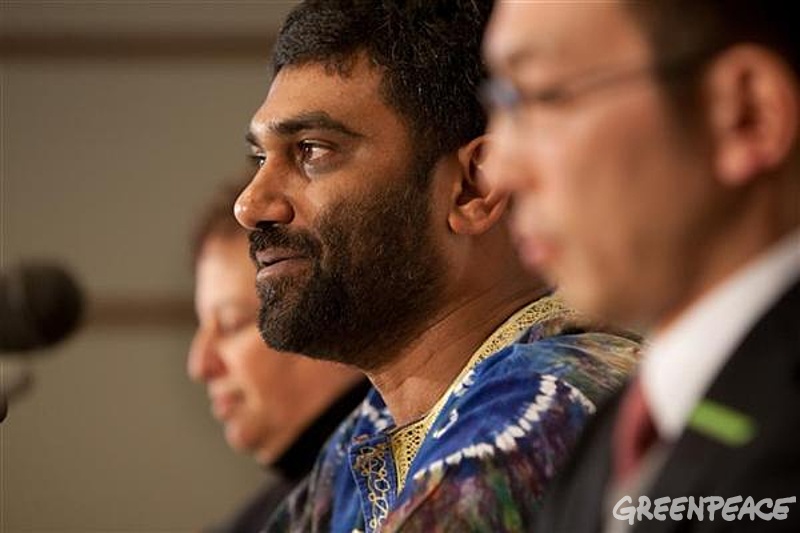Too many powerful fishing boats
We all know the oceans are in trouble. Since “large-scale fishing” began in 1952, the abundance of large oceanic fish has decreased globally by 90%. Too many boats with too much capacity are chasing too few fish. Bottom trawlers drag nets across sea beds and coral reefs, cutting down everything in their path. The heavy-duty fishing lines in use by the “long-line industry” could encircle the globe 550 times. Fishing vessels, and airplanes that track schools of fish illegally, are equipped with so much detection equipment, fish have no chance of escaping. Check out my review of the fact-filled documentary “End of the Line: Where have all the fish gone?” for more on that score. The whole story of the exploitation of our oceans is pretty scary.
Meeting Kumi Naidoo
But in a sea of bad news, I heard some good news last week. For one thing, I met the inspiring director of Greenpeace, and heard a little about Greenpeace’s campaign to save our oceans. Read on for details. The second thing I want to tell you is an important new report from a no-fishing-zone in Mexico.
But first things first.

Kumi Naidoo, Exec Dir of Greenpeace International. Photo used with permission. © Jeremy Sutton-Hibbert / Greenpeace
Greenpeace’s dynamic director – you gotta see this guy speak
Kumi Naidoo is Greenpeace’s International Executive Director. He was in my hometown last week (Charlotte) to help us fight the merger of the coal-burning Duke Energy with Progress Energy, a merger that would make Duke the biggest and most powerful utility in the U.S.
But Kumi talked about a lot of things – including oceans. He said that Greenpeace is trying to get 40% of our total ocean area declared fishing sanctuaries, or no-fishing-zones. I love it. It’s a huge goal, but who knows. With Kumi at the helm, nothing would surprise me. This man is fearless, tried-and-true. And Greenpeace has a long history of effective ocean activism. Consider supporting their campaigns by visiting their website.
Now, the second thing I wanted to mention – a very hopeful scientific report I saw last week, which was coincidentally related to Kumi’s comments about fish sanctuaries.
Good news!
Mexico’s Gulf of California has a national marine park that’s been closed to fishing since 1995. A 1999 survey of the 71-square-kilometer park found no big fish, no top predators such as giant grouper or snappers. These big fish are the most common targets for fishers.
But there’s been a turn-around. A recent survey showed that the fishing ban has had a dramatic effect! In the years since the park has been protected, the total mass of fish in the park has quintupled. The number of top predators has also soared. These big fish are indicators of a healthy ecosystem. Both of these trends are the opposite of those for fish in unprotected waters of the Gulf.
The park is Cabo Pulmo National Marine Park, located close to where the Gulf of California meets the Pacific Ocean. This study of Cabo Pulmo is a model for over-harvested oceanic areas – which could include most of the ocean perhaps. It’s a strong argument for the creation of more fish sanctuaries, and counters the skeptics who’ve said that no-fishing-zones could have no effect.
“People who object to marine protected areas, especially to strong protection like here, often say there is no proof that they work,” says Elliott Norse of the Marine Conservation Institute in Bellevue, Washington. “Well here is the proof.”
Although protection of the park has overall been a huge success, sharks remain rare in the park, because of heavy over-harvesting for the fin trade as well as slow reproduction rates.
This study was published in the August 12 PLoS ONE (an online science journal) by Octavio Aburto-Oropeza and his colleagues of the Scripps Institution of Oceanography in La Jolla, California.
Want more?
If you want more detail about the destructive capacity of modern fishing, check out my review of the fact-filled documentary “End of the Line: Where have all the fish gone?“. This film and the original book version by Charles Clover are both on Amazon. Another good book about the over-harvesting of our oceans is The Empty Ocean by Richard Ellis.
To learn about solutions and actions you can take, see the Greenpeace website.
Keywords: Greenpeace fish sanctuaries no fishing zones Kumi Naidoo End of the Line Cabo Pulmo National Marine Park Octavio Aburto-Oropeza Elliot Norse Scripps shark fins





